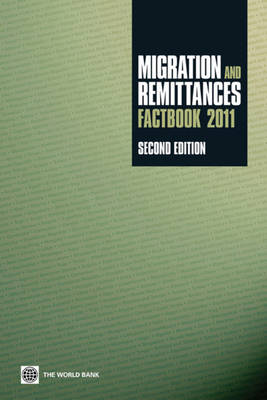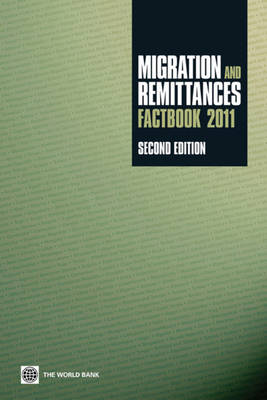
- Retrait en 2 heures
- Assortiment impressionnant
- Paiement sécurisé
- Toujours un magasin près de chez vous
- Retrait gratuit dans votre magasin Club
- 7.000.0000 titres dans notre catalogue
- Payer en toute sécurité
- Toujours un magasin près de chez vous
Migration and Remittances Factbook 2011
Dilip Ratha, Sanket Mohapatra, Ani Silwal
Livre broché | Anglais
67,95 €
+ 135 points
Description
The Migration and Remittances Factbook 2011 updates the 2008 edition of the Factbook with additional data for 71 countries collected from various sources, including national censuses, labor force surveys, population registers, and other national sources. The Factbook attempts to present numbers and facts behind the stories of international migration and remittances, drawing on authoritative, publicly available data. It provides a snapshot of statistics on immigration, emigration, skilled emigration, and remittance flows for 210 countries and 15 regional and income groups. Some interesting facts emerge: -More than 215 million people, or 3 percent of the world population, live outside their countries of birth. Current migration flows, relative to population, are weaker than those of the last decades of the nineteenth century. -The top migrant destination countries are the United States, the Russian Federation, Germany, Saudi Arabia, and Canada. The top immigration countries, relative to population, are Qatar (87 percent), the United Arab Emirates (70 percent), Kuwait (69 percent), Andorra (64 percent), Cayman Islands (63 percent), and Northern Mariana Islands (62 percent). -The United States is likely to have seen the largest inflows of migrants between 2005 and 2010, despite the global financial crisis. The expansion of the European Union led to a surge of migrant flows to Spain, Italy, and the United Kingdom, with a large share from Eastern Europe. -The six Gulf Cooperation Council countries (Saudi Arabia, United Arab Emirates, Bahrain, Qatar, Oman, and Kuwait) have also seen a significant increase in migrant flows in the last few years, mostly from South Asia and East Asia. However, immigrant stocks in all regions started to plateau in 2009-10 because of the global financial crisis. -The volume of South-South migration is larger than migration from the South to the high-income countries belonging to the Organization of Economic Cooperation and Development (OECD). High-income non-OECD countries such as the Gulf countries are also major destinations for migrants from the South. South-South migration is significantly larger than South-North migration in Sub-Saharan Africa (73 percent) and Europe and Central Asia (61 percent). -According to available official data, the Mexico-United States corridor is the largest migration corridor in the world, accounting for 11.6 million migrants in 2010. Migration corridors in the Former Soviet Union -- Russia-Ukraine, and Ukraine-Russia -- are the next largest, followed by Bangladesh-India. In these corridors, natives became migrants without moving when new international boundaries were drawn. -Smaller countries tend to have higher rates of skilled emigration. Almost all physicians trained in Grenada and Dominica have emigrated abroad. St. Lucia, Cape Verde, Fiji, São Tomé and Principe, and Liberia are also among the countries with the highest emigration rates of physicians. -Refugees and asylum seekers made up 16.3 million or 8 percent of international migrants in 2010. The share of refugees in the population was 14.6 percent in the low-income countries--more than seven times larger than the share of 2.1 percent in the high-income OECD countries. Middle East and North Africa had the largest share of refugees and asylum seekers among immigrants (65 percent), followed by Sub-Saharan Africa (17 percent), South Asia (20 percent), and East Asia and Pacific (8.8 percent). -Worldwide remittance flows are estimated to have exceeded $414 billion in 2009, of which developing countries received $307 billion (This represents a small decline of 6 percent from the level in 2008). The true size, including unrecorded flows through formal and informal channels, is believed to be significantly larger. Recorded remittances are more than twice as large as official aid and nearly two-thirds of foreign direct investment (FDI) flows to developing countries. -In 2009, the top recipient countries of recorded remittances were India, China, Mexico, the Philippines, and Poland. As a share of GDP, however, smaller countries such as Tajikistan (50 percent), Tonga (38 percent), Moldova (31 percent), the Kyrgyz Republic (28 percent), and Lesotho (27 percent) were the largest recipients in 2008. -Rich countries are the main source of remittances. The United States is by far the largest, with $46 billion in recorded outward flows in 2008. Russia ranks as the second largest, followed by Switzerland and Saudi Arabia.
Spécifications
Parties prenantes
- Auteur(s) :
- Editeur:
Contenu
- Nombre de pages :
- 286
- Langue:
- Anglais
Caractéristiques
- EAN:
- 9780821382189
- Date de parution :
- 15-11-10
- Format:
- Livre broché
- Format numérique:
- Trade paperback (VS)
- Dimensions :
- 150 mm x 226 mm
- Poids :
- 385 g

Seulement chez Librairie Club
+ 135 points sur votre carte client de Librairie Club
Les avis
Nous publions uniquement les avis qui respectent les conditions requises. Consultez nos conditions pour les avis.








